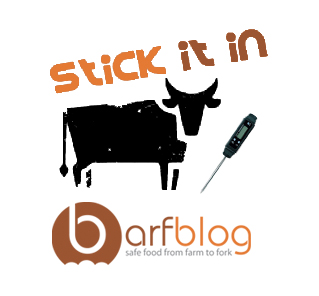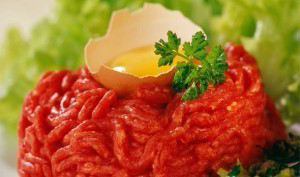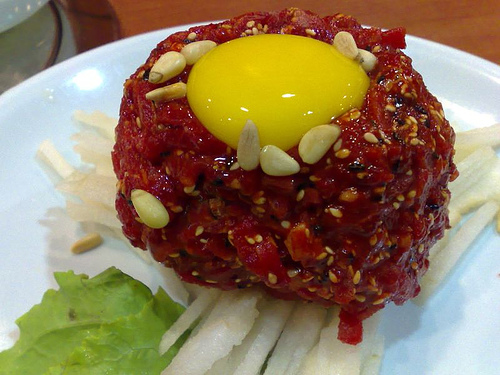Health officials in New Brunswick are clamping down on restaurants serving beef tartare because the dish, considered by some a delicacy, violates the province’s food regulations.
 Kevin Bissett of The Globe and Mail writes that over the past month, 11 restaurants have been given notice to stop serving raw or undercooked meat. The notice came as a surprise to chef Luc Doucet at the Black Rabbit restaurant in Moncton, N.B.
Kevin Bissett of The Globe and Mail writes that over the past month, 11 restaurants have been given notice to stop serving raw or undercooked meat. The notice came as a surprise to chef Luc Doucet at the Black Rabbit restaurant in Moncton, N.B.
“I was blindsided,” he said in an interview Monday. “I got an email from health inspector that they needed a meeting and they showed up Thursday and served us a letter to cease all tartare operations and take it off the menu.”
The letter said current regulations don’t allow such foods to be served. “Our department was recently made aware that ground beef prepared as per the request of the customer and/or steak tartare is presently available at your food premises,” the letter stated. “This practice must cease immediately as it is in direct violation of the New Brunswick food regulation.”
Doucet said it appears officials were responding to a complaint, even though he’s never heard of anyone becoming sick from eating the dish (huh? – dp). He said he didn’t appreciate the way officials addressed the issue.
“It was not to ask us to provide our procedure for tartare or ground beef at the restaurant,” he said. “It was more, cease every dish that you have, and a lot of my restaurant friends have tartare on the menu.”
Of concern is that undercooked meat can contain pathogens that can make people sick. In a statement, the province said it’s working on establishing how such dishes can be served safely.
“These letters have not been issued as the result of people becoming ill from consuming these foods — instead, they are issued because of general food safety concerns, as eating raw or lightly cooked meats may increase the risk of food poisoning,” wrote Bruce Macfarlane, a spokesman for the Department of Health.
New Brunswick regulations include minimum cooking temperatures for meats such as beef, pork and poultry. The statement said for items like sushi and sous vide, policies are in place to support safe consumption.
Doucet said his beef tartare is composed of a quality cut of meat that is sliced in small cubes rather that ground up, and he said he has sampled tartare in restaurants across the country.
“Every time I go to Quebec, I have tartare in some form,” he said.






 techniques in Australian abattoirs were "top class and only getting better." By Feb. 6, 1995, Garibaldi Smallgoods declared bankruptcy. Sales of smallgoods like mettwurst were down anywhere from 50 to 100 per cent according to the National Smallgoods Council.
techniques in Australian abattoirs were "top class and only getting better." By Feb. 6, 1995, Garibaldi Smallgoods declared bankruptcy. Sales of smallgoods like mettwurst were down anywhere from 50 to 100 per cent according to the National Smallgoods Council.
 Mongols and Turks who, under the leadership of Genghis Khan, conquered much of Asia and eastern Europe in the early 13th century. I can’t vouch for the safety of what they ate.
Mongols and Turks who, under the leadership of Genghis Khan, conquered much of Asia and eastern Europe in the early 13th century. I can’t vouch for the safety of what they ate. Choose your poisons.
Choose your poisons. Netherlands. In 2006 to 2008, despite intensive monitoring and control programmes, Salmonella was still found in-store in raw meats (such as steak tartare and ossenworst) intended for direct consumption.
Netherlands. In 2006 to 2008, despite intensive monitoring and control programmes, Salmonella was still found in-store in raw meats (such as steak tartare and ossenworst) intended for direct consumption.